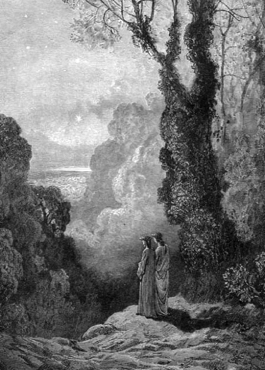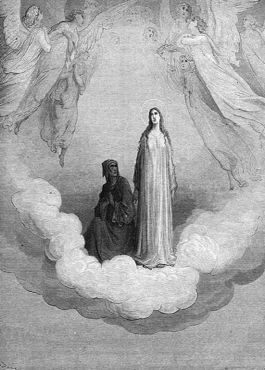


Poetry:
There is far too much to say on this topic, but I wanted a repository for some basic terms and ideas, both for Dante specifically, and for poetry more generally.
The Divine Comedy is generally classified as an epic poem. Poetry can be lyric (generally concerned with the interior emotional and mental life of the poet), dramatic (the direct speech of characters in a play set in verse), didactic (poetry meant to teach the reader something), or epic (poetry that narrates events and actions, generally serious in nature and large in scale, such as the fall of Troy or the founding of Rome). To some degree, of course, the Comedy is all of these things: characters express their innermost feelings, their speech is directly reported, and the poem is strongly didactic in nature.
The Comedy is divided into three books, conventionally referred to as cantiche (the singular is cantica): Inferno, Purgatorio, Paradiso. (Most English translations use the Italian titles of the cantiche.) Each cantica is divided into 33 canti (literally "songs"), which correspond to something like the chapters in a modern novel. In addition, there is 1 extra canto in Inferno, usually regarded as an introductory canto, producing a work with exactly 100 canti. Each canto has a variable number of lines or verses, but most are approximately the same length.
Dante uses, very famously, an unusual rhyme scheme called terza rima (literally, "third rhyme").
Nel mezzo del cammin di nostra vita
mi ritrovai per una selva oscura
ché la diritta via era smarrita.
Ahi quanto a dir qual era è cosa dura
esta selva selvaggia e aspra e forte
che nel pensier rinova la paura!
Tant'è amara che poco è più morte;
ma per trattar del ben ch'i' vi trovai,
dirò de l'altre cose ch'i' v'ho scorte.
Io non so ben ridir com'i' v'intrai,
tant'era pien di sonno a quel punto
che la verace via abbandonai.
As you can see, the rhyme scheme is A B A B C B C D C D E D… each rhyme gets used three times, as old rhymes drop away and a new rhyme is woven in—I say "woven" advisedly, because the scheme is basically a rhyming braid. Terza rima has no "natural" end: there is always a rhyme that does net get its third appearance, and indeed, the poem begins with an incomplete rhyme (vita/smarrita).
Throughout the Comedy, Dante uses the standard poetic line in Italian, the "hendecasyllable." This is a line with 11 syllables (Nota bene: Italians also divide syllables differently ). You may be familiar with the standard poetic line in English, iambic pentameter, which is ten syllables divided into five "feet" that have a similar rhythm. Like other Romance languages, however, Italian poetry is not driven by poetic feet; hendecasyllables have only a limited number of typical stress patterns (always the 10th syllable, plus either the 4th, the 6th, or both—with many possible variations). Graduate students in Italian should certainly be familiar with the basics of Italian meter; here's a helpful handout from Unibo.
Enough about meter—we're probably more interested in the meaning of the poem rather than its form (but I hasten to note that meaning is produced also by form, and by the combination or contrast between meaning and form). Poetry habitually uses figures of speech to express its content. So Dante does not write something painful and literal like:
When I was about 35 (expecting to live to be about 70)
I realized that I was morally and ethically confused
and no longer knew what the right thing to do was.
Instead, he uses a series of metaphors, in which the poet substitutes one thing for another. Life is a voyage, a voyage that Dante has completed about half of. His ethical and moral confusion is a dark wood, and he has lost the "straight path" (this is itself a metaphor in which straightness is identified with correctness, and crookedness is associated with error). The single most common figure of speech in Dante, however, is not the metaphor, but the analogy. An analogy is when the poet explains one thing through another. Here's a beautiful example from Inferno II:
Just as little flowers, bent and closed
from the night's chill, then when the sun
brightens them, rise up all open on the stem,
so did I to my tired virtue,
and such good ardor ran to my heart,
that I began as a free person.
Analogy in Dante almost always appears introduced by the words tale and quale, which may appear in either order, and are rendered in English variously as "just like" and "so" or "much as" and "so," or similar phrases. They are often long, sometimes very, very much so.
While metaphor and analogy are perhaps the most common figures of speech in Dante, he knew his rhetoric manuals very well, and we find many, many others, from hysteron proteron (Paradiso II) to anaphora (Inferno III) and many others besides. If we are lucky, we shall even find a zeugma this semester (there are at least two in the Comedy). As students of poetry, you should be familiar with (besides metaphor and analogy):
allegory: an extended metaphor, such as the whole Divine Comedy
alliteration: repetition of initial consonants ("he beat his bloody breast")
allusion: a reference to another text that requires the reader know the other text
analogy: an explanation of one thing in terms of another (see the "tale… quale" above)
anaphora: repetition of a word or a phrase at the start of a line
antithesis: a deliberate contrast or opposition ("Many are called, few are chosen")
apostrophe: a direct exclamation or address to an absent figure ("O Moon")
assonance: repetition of the same or similar vowel sounds ("omo non sono")
cacophony: deliberately harsh or unpleasant sounds
chiasmus: A B followed by B A ("ask not what your country can do for you…")
climax: words or phrases grow more and more emphatic ("I came, I saw, I conquered")
ekphrasis: the attempt to paint a vivid picture with words
hyperbole: exaggeration for effect
irony: much misunderstood; often—incorrectly—taken to mean only verbal irony
litotes: affirming something through denial of a negative ("she's not unattractive")
metaphor: a literal term is substituted by a figurative one ("he's a real rat")
metonymy: instead of a literal term, a term associated is used instead ("Hollywood is corrupt")
oxymoron: an apparent contradiction that nonetheless means something ("living dead")
parallellism: a series of phrases each of which follows the same logic or structure
personifcation: attributing human qualities to the non-human ("the storm grew angrier")
simile: a literal term is likened to a figure term ("he's like a mouse training to be a rat")
synechdoche: a part is used to represent the whole, or the reverse ("all hands on deck!")
synesthesia: multiple senses are invoked simultaneously ("the woods smelled green")
tautology: a statement which is inherntly true ("a man's gotta do what a man's gotta do")
zeugma: one term is linked to two others—but one link is proper, the other, improper.